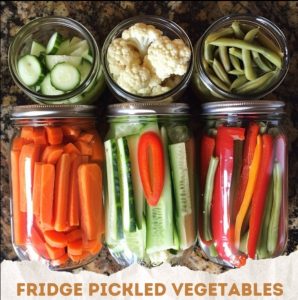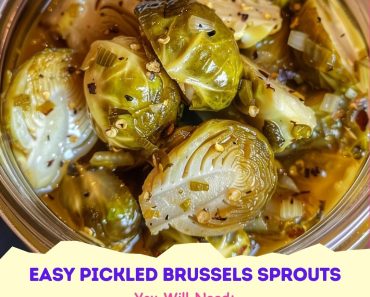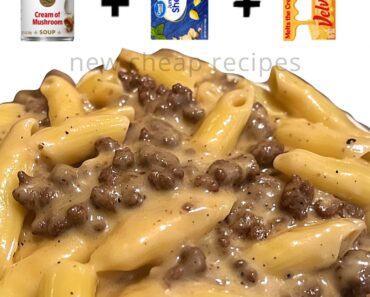
Homemade Fridge Pickled Vegetables
Indulge in the refreshing and tangy flavors of homemade fridge pickled vegetables, a perfect way to add a burst of flavor to your meals. This recipe is not just simple and quick but also incredibly versatile. Let’s dive into the colorful and vibrant world of pickled veggies that will bring a touch of zest to your culinary creations!
Ingredients Overview
White Vinegar: This is the base of our pickling liquid, providing the essential tanginess that gives pickles their distinctive flavor.
Water: Balances the acidity of the vinegar, making the pickling solution milder.
Sugar: Adds a hint of sweetness to counteract the acidity, creating a balanced flavor profile.
Salt: Essential for flavor and for helping to preserve the vegetables.
Mixed Vegetables: The stars of this recipe! Use a colorful mix of carrots, cucumbers, bell peppers, and cauliflower for a variety of textures and flavors.
Garlic: Adds a delightful pungency and depth to the pickling solution.
Mustard Seeds: Infuse the pickles with a subtle spiciness and complexity.
Black Peppercorns: Offer a gentle heat and aromatic quality to the pickles.
Red Pepper Flakes (Optional): For those who like a bit of a kick, these flakes add a touch of heat.
Fresh Dill or Other Herbs (Optional): Fresh herbs like dill bring a burst of freshness and herbal notes to the pickles.
Step-by-Step Cooking Instructions
Step 1: Prepare the Pickling Solution In a saucepan, combine 1 cup of white vinegar, 1 cup of water, 2 tablespoons of sugar, and 1 tablespoon of salt. Bring to a Boil over medium heat, stirring until the sugar and salt are completely dissolved. This will take about 5 minutes.
Step 2: Prepare the Vegetables While the pickling solution is heating, Slice the Vegetables into bite-sized pieces. Place in Jar: Layer the mixed vegetables, 2 sliced garlic cloves, 1 teaspoon of mustard seeds, 1 teaspoon of black peppercorns, 1/2 teaspoon of red pepper flakes (if using), and fresh herbs (if using) in a clean, large jar.
Step 3: Add the Pickling Solution Pour Over Vegetables: Carefully pour the hot vinegar mixture over the vegetables, ensuring they are completely submerged. Close the Jar with a tight-fitting lid.
Step 4: Cool and Refrigerate Let Cool: Allow the jar to cool to room temperature. Refrigerate: Once cooled, refrigerate the jar for at least 2 hours, or overnight for the best flavor. The longer the vegetables pickle, the more flavorful they will become.
Step 5: Serve and Enjoy Serve Chilled: Enjoy these pickled vegetables as a snack, or side dish, or add them to your salads and sandwiches for an extra zing. Storage: Store in the refrigerator for up to 2 weeks.
Valuable Tips for a Seamless Cooking Experience
Tip: Ensure Vegetables Are Submerged: Make sure all the vegetables are fully submerged in the pickling liquid to ensure even pickling.
Tip: Use Fresh Herbs for Extra Flavor: Fresh dill or other herbs can elevate the flavor of your pickles. Simply tuck a few sprigs into the jar with the vegetables.
Tip: Experiment with Spices: Don’t be afraid to experiment with different spices and herbs. Coriander seeds, fennel seeds, or bay leaves can add unique flavors.
Storage and Reheating Tips
Storage: Keep the pickled vegetables in a sealed jar in the refrigerator. They will stay fresh for up to 2 weeks.
Reheating: These pickles are best enjoyed cold or at room temperature. There’s no need to reheat them, as they are meant to be a refreshing, crisp addition to your meal.
1. What vegetables can I use for pickling?
You can use a variety of vegetables such as carrots, cucumbers, bell peppers, cauliflower, radishes, green beans, and even zucchini.
2. How long do fridge pickled vegetables last?
They can last up to 2 weeks when stored properly in the refrigerator.
3. Can I reuse the pickling solution?
It’s not recommended to reuse the pickling solution as it loses its potency and can become diluted.
4. Is it necessary to sterilize the jars?
While it’s not necessary for fridge pickles, using clean jars is essential to prevent contamination.
5. Can I reduce the amount of sugar in the recipe?
Yes, you can adjust the sugar to your taste preference.
6. What if I don’t have mustard seeds?
You can skip them or substitute with other spices like coriander seeds or fennel seeds.
7. Can I use apple cider vinegar instead of white vinegar?
Yes, apple cider vinegar can be used for a different flavor profile.
8. How soon can I eat the pickled vegetables?
You can eat them after a few hours, but they taste best if left to pickle overnight.
9. Do I need to cook the vegetables before pickling?
No, the hot pickling solution will slightly soften the vegetables, leaving them crisp.
10. What type of salt should I use?
Use non-iodized salt like kosher salt or pickling salt to avoid cloudiness in the brine.
11. Can I add other flavors?
Yes, you can add spices like coriander seeds, dill seeds, or even ginger slices for extra flavor.
12. What if my pickles are too salty?
Rinse the vegetables briefly under cold water before eating to reduce the saltiness.
13. Can I pickle fruits using this recipe?
Yes, fruits like apples, pears, and berries can be pickled using a similar process.
14. Do I need to keep the pickles refrigerated?
Yes, fridge pickles should always be kept refrigerated.
15. How can I tell if the pickles have gone bad?
If the pickles develop an off odor, taste, or appearance, or if mold appears, they should be discarded.
16. Can I make pickled vegetables without sugar?
Yes, but the flavor will be more tart and less balanced.
17. Why did my pickles turn out mushy?
Using overripe vegetables or not cooling the pickling solution enough before pouring can cause mushiness.
18. Can I pickle vegetables whole?
Yes, but slicing them allows the pickling solution to penetrate better.
19. Can I freeze the pickled vegetables?
Freezing is not recommended as it changes the texture of the vegetables.
20. Are pickled vegetables healthy?
Yes, they are low in calories and can be a good source of probiotics if fermented properly.
Helpful Tips
- Use fresh, firm vegetables for the best texture.
- Cut vegetables into uniform pieces for even pickling.
- Always use a non-reactive pot and utensils (like stainless steel or glass).
- Let the pickling solution cool slightly before pouring over delicate vegetables to prevent them from cooking.
- Pack the vegetables tightly in the jar but avoid crushing them.
- Leave some headspace in the jar to allow the brine to fully cover the vegetables.
- Use a funnel to pour the brine without making a mess.
- Label your jars with the date of preparation for tracking freshness.
- Experiment with different herbs and spices to create unique flavors.
- Shake the jar gently every few days to redistribute the brine.
- Taste your pickles periodically to check for desired flavor.
- Store jars in the back of the refrigerator where it’s colder for better preservation.
- Use filtered water if your tap water has a strong taste.
- Always use fresh herbs rather than dried for better flavor.
- Sterilize jars if planning to keep pickles longer than 2 weeks.
- Avoid using iodized salt as it can cause cloudiness in the brine.
- Ensure the vegetables are fully submerged to prevent mold growth.
- Use pickled vegetables to add flavor to dishes like tacos, sandwiches, and salads.
- Reserve some brine to make a quick salad dressing or marinade.
- Keep trying different combinations of vegetables and seasonings to find your favorite mix.
Secrets
- Adding a grape leaf to the jar helps keep the vegetables crisp.
- Use a pinch of turmeric for a vibrant yellow color.
- Adding a slice of beet can give your pickles a beautiful pink hue.
- A few slices of ginger can add a unique zing to your pickles.
- A tablespoon of honey can be used instead of sugar for a different flavor.
- Using rice vinegar gives a subtle sweetness and less sharp acidity.
- Pickling spices blends are available that can simplify your seasoning process.
- Including a bay leaf adds a complex flavor to the brine.
- For extra crunch, soak vegetables in ice water for an hour before pickling.
- Experiment with adding a splash of lemon or lime juice for citrus notes.
- Whole spices retain their flavor longer than ground spices in pickling.
- Use a mandoline slicer for perfectly even vegetable slices.
- Pickling onions separately in a sweeter brine can add a delightful condiment.
- Adding horseradish can give a spicy kick to your pickles.
- Fermenting pickles for a few days before refrigerating can add probiotic benefits.
- Using apple cider vinegar can add a natural sweetness and complexity.
- Keeping the jar tilted while filling helps pack more vegetables in.
- Use leftover pickle brine to make a tangy vinaigrette.
- Adding a touch of smoked paprika can give a smoky flavor to your pickles.
- Incorporating tea leaves in the brine can add tannins that help keep pickles crisp
Health Benefits
Pickled vegetables are not only tasty but also packed with benefits:
- Probiotics: Fermented pickles are rich in beneficial bacteria.
- Low Calorie: They are a low-calorie snack option.
- Rich in Antioxidants: Vegetables like bell peppers and carrots are high in antioxidants.
- Digestive Aid: The acidity of pickles can help with digestion.
Variations
- Spicy Pickles: Add more red pepper flakes or a few slices of jalapeno.
- Sweet Pickles: Increase the amount of sugar or add a bit of honey.
- Asian-Inspired Pickles: Use rice vinegar, ginger, and a bit of soy sauce.
- Mediterranean Pickles: Add garlic, oregano, and lemon slices.
- Fruit Pickles: Try pickling fruits like peaches or pears with a sweeter brine.
Common Mistakes and How to Avoid Them
- Using Iodized Salt: Can cause cloudiness—use non-iodized salt instead.
- Overpacking the Jar: Can cause uneven pickling—pack tightly but not too much.
- Pouring Hot Brine Over Delicate Veggies: Can cook them—let the brine cool slightly.
- Not Enough Brine: Ensure vegetables are fully submerged to avoid spoilage.
- Improper Storage: Always refrigerate fridge pickles.
Serving Suggestions
- Salads: Add pickled vegetables to your salads for a tangy crunch.
- Sandwiches: Use them in sandwiches or burgers for extra flavor.
- Tacos: A great topping for tacos, adding freshness and acidity.
- Cheese Platters: Include them in cheese or charcuterie boards.
- Snacks: Enjoy them straight from the jar as a healthy snack.
Storing and Shelf Life
- Refrigeration: Always store pickles in the refrigerator.
- Shelf Life: They last up to 2 weeks in the fridge.
- Freezing: Not recommended as it changes the texture.
- Reuse Brine: Do not reuse the brine as it loses potency.
Conclusion
With this homemade fridge pickled vegetables recipe, you’ll bring a burst of flavor to your meals effortlessly. Enjoy the process of creating these tangy delights and savor the fresh, crisp taste they add to your dishes. Happy pickling!








